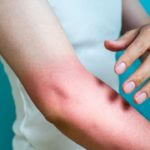
Happy, Healthy Summer
Summer, summer, summertime. School is out, and the temperatures are rising. The warm weather is perfect for a much need vacation. Swimming, beach trips, camping, and cookouts are perfect items for your summer to-do list. If you’re planning on enjoying summer in the desert, be ready for the heat! Temperatures during the summer on an average day stay in the triple digits, and while some sun is healthy, too much could be bad for your health.
UV rays carry a healthy dose of vitamin D, an essential to human health. To be able to absorb calcium and phosphorus from food and to assist in bone development, vitamin D plays a big part. The World Health Organization recommends 5 to 15 minutes of sun exposure 2 to 3 times a week. However, this comes with risks, including sunburn and skin cancer. Before stepping into the sun, it’s important to take the proper steps to protect your skin. We highlighted some sun safety tips to help enjoy the heat all summer long.
Prepare for The Sun
Sunscreen
Although sunscreen is essential for everyday protection when summer comes around, the days are longer, and the sun is stronger. Make sure you read the labels and choose the right SPF for your skin and outdoor activities.
• Always select “broad-spectrum” sunscreen. This protects against UVB and UVA rays. Although all sunscreen products protect against UVB rays, UVA rays also contribute to skin cancer and premature aging. Sunscreen that isn’t “broad-spectrum” only protects against sunburns, not skin cancer or aging.
• Sunscreen does come with an expiration date. Most sunscreen products are good for 2 to 3 years. Some that have been exposed to heat for long may be less effective.
• Generously re-apply every 2 hours for the best summer sun protection. It’s important to choose a protector with an SPF of 30 or higher. The SPF number is the protection level provided against UVB rays. The length of sunscreen protection depends on your outdoor activities and the SPF level of the sunscreen.
• Pay attention to water-resistant sunscreen. Some sunscreens aren’t entirely waterproof, so make sure to read the label before you buy if you’re planning for a day by the water. Most sunscreens come with labels that read “water resistant,” and specifies how long it lasts. For better protection, it’s important to reapply often if you are swimming or sweating.
Protective Clothing
Sunscreen, check. Now it’s time for extra protection with the right accessories. It’s recommended to wear a wide-brimmed hat to shade your face, head, ears, and neck. Although glasses are usually seen as a fashion accessory, they can also protect your eyes from UV rays. Pick up some sunglasses that contain UV-filtering for extra protection.
Did you know, the clothing you wear can also affect your sun protection? Stay summer sun safe with clothes that cover your arms and legs. Light-colored and loosely woven clothing provides less protection than darker and tightly-woven material. Darker colors and heavier woven fabrics help absorb UV, which helps reduce exposure. To ensure that your clothes offer enough protection, put your hand inside your garments and make sure you can’t see it through them.
 Exposure Time
Exposure Time
The longer you’re exposed to the sun, the more rays your skin absorbs. Try your best to stay in the shade when the sun is at its strongest from 10 a.m. to 4 p.m. Keep in mind that even on a cool or overcast day, UV rays still reach the earth, and the “invisible sun” can still cause sunburn and skin damage.
Check the UV Index
UV radiation is a form of non-ionizing radiation that is released by the sun and artificial sources, like tanning beds. Overexposure to UV radiation admitted by the sun can lead to serious health issues. However, you can use the UV Index for proper sun protection recommendations. We encourage you to use this index when planning your summer activities so that you can enjoy the outdoors longer!
The US Environmental Protection Agency and National Weather Service provide a forecast of predicted UV ray strength. This information can be viewed by downloading the EPA app on your smartphone or web app.
Summer Sun Safety in The Desert Fun in the sun is great until sunburns happen. While planning your summer activities, make sure protecting your skin and stay hydrated are top priorities.
Even when you do the best to protect your skin, sometimes it isn’t enough. VIP Urgent Care is here to assist your medical needs. We are the most comprehensive provider in the Coachella Valley and will give you the highest level of urgent care.
Always consult your physician before beginning any exercise program. This general information is not intended to diagnose any medical condition or to replace your healthcare professional.
